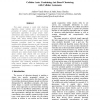Free Online Productivity Tools
i2Speak
i2Symbol
i2OCR
iTex2Img
iWeb2Print
iWeb2Shot
i2Type
iPdf2Split
iPdf2Merge
i2Bopomofo
i2Arabic
i2Style
i2Image
i2PDF
iLatex2Rtf
Sci2ools
ICTAI
2005
IEEE
2005
IEEE
Cellular Ants: Combining Ant-Based Clustering with Cellular Automata
This paper proposes a novel data clustering algorithm, coined ‘cellular ants’, which combines principles of cellular automata and ant colony optimization algorithms to group similar multidimensional data objects within a two-dimensional grid. The proposed method assigns data objects to unique ants, which actively move around, leave pheromones and follow trails of similar ants. Cellular automata principles based on simple, discrete neighborhood densities determine an ant’s directional movements, so that clusters emerge. The novel concept of ‘positional swapping’ organizes these clusters internally based on multi-dimensional data value similarity. As a result, shared cluster borders in grid space contain data objects that are nearby in parameter space. This method is algorithmically simple, as it is based on a few user-chosen variables and uses fixed discrete values instead of probability algorithms. This clustering technique is evaluated using several datasets, while its meth...
Artificial Intelligence | Cellular Automata | ICTAI 2005 | Method Assigns Data | Similar Multidimensional Data |
| Added | 25 Jun 2010 |
| Updated | 25 Jun 2010 |
| Type | Conference |
| Year | 2005 |
| Where | ICTAI |
| Authors | Andrew Vande Moere, Justin James Clayden |
Comments (0)

